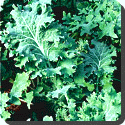 Kale — Kale or Borecole is a form of cabbage (Brassica oleracea Acephala Group), green in color, in which the central leaves do not form a head. It is considered to be closer to wild cabbage than most domesticated forms. The species Brassica oleracea contains a wide array of vegetables, including broccoli, cauliflower, and Brussels sprouts. The Cultivar Group Acephala also includes spring greens and collard greens, which are extremely similar genetically.
Kale — Kale or Borecole is a form of cabbage (Brassica oleracea Acephala Group), green in color, in which the central leaves do not form a head. It is considered to be closer to wild cabbage than most domesticated forms. The species Brassica oleracea contains a wide array of vegetables, including broccoli, cauliflower, and Brussels sprouts. The Cultivar Group Acephala also includes spring greens and collard greens, which are extremely similar genetically.
The most important growing areas lie in central and northern Europe and North America. Kale grows more rarely in tropical areas as it prefers cooler climates. Kale is the most robust cabbage type – indeed the hardiness of kale is unmatched by any other vegetable. Kale will also tolerate nearly all soils provided that drainage is satisfactory. Another advantage is that kale rarely suffers from pests and diseases of other members of the cabbage family – pigeons, club root and cabbage root fly (Delia radicum). Places where kale grows are called kalefields.
Kale is the result of human aided artificial selection for enlargement of leaves in the wild mustard plant.
Kale freezes well and actually tastes sweeter and more flavorful after being exposed to a frost.
Tender kale greens can provide an intense addition to salads, particularly when combined with other such strongly-flavored ingredients as dry-roasted peanuts, tamari-roasted almonds, or red pepper flakes.
In the Netherlands it is very frequently used in the winter dish stamppot and seen as one of the country’s traditional dishes, called Boerenkool.
 Kids Portal For Parents India Kids Network
Kids Portal For Parents India Kids Network






